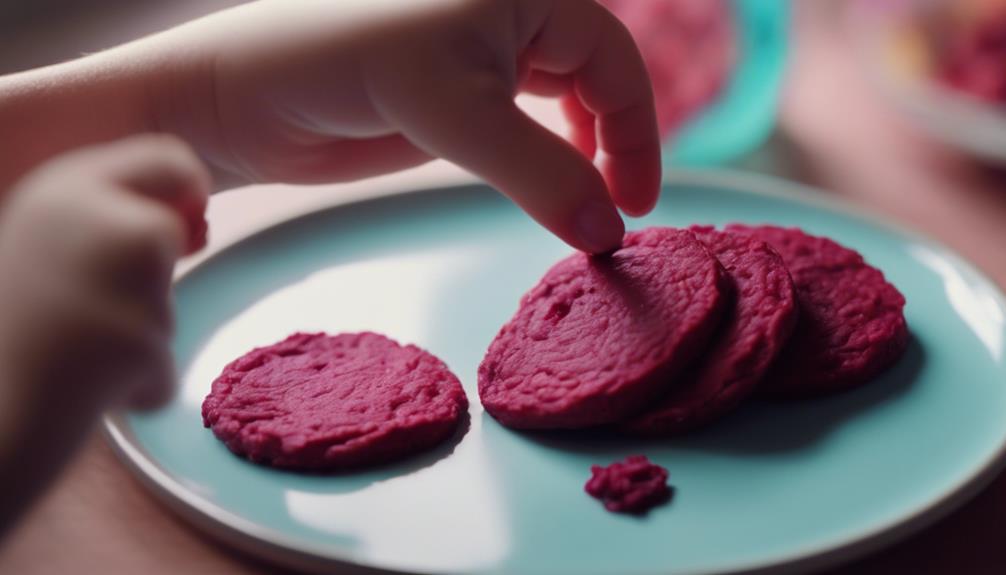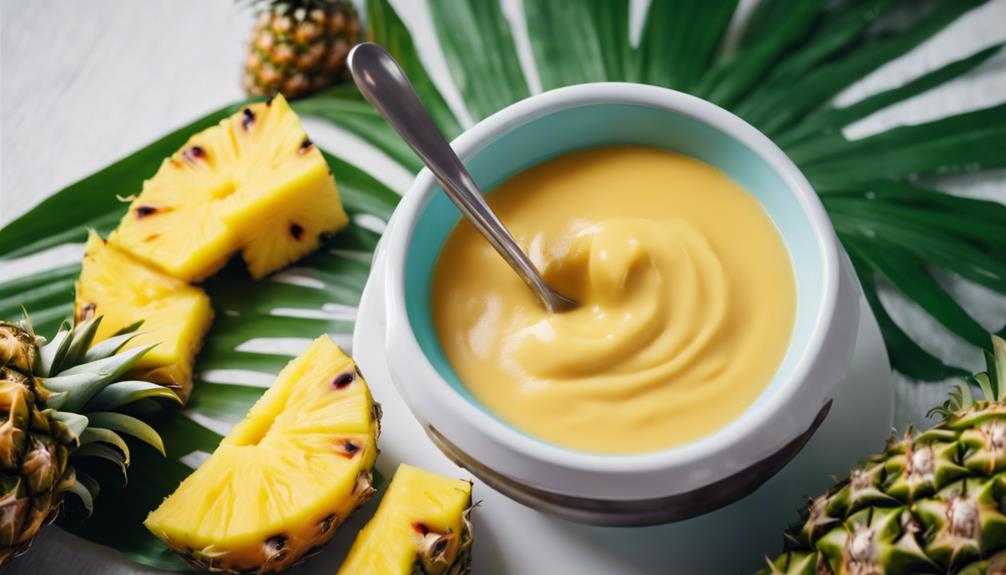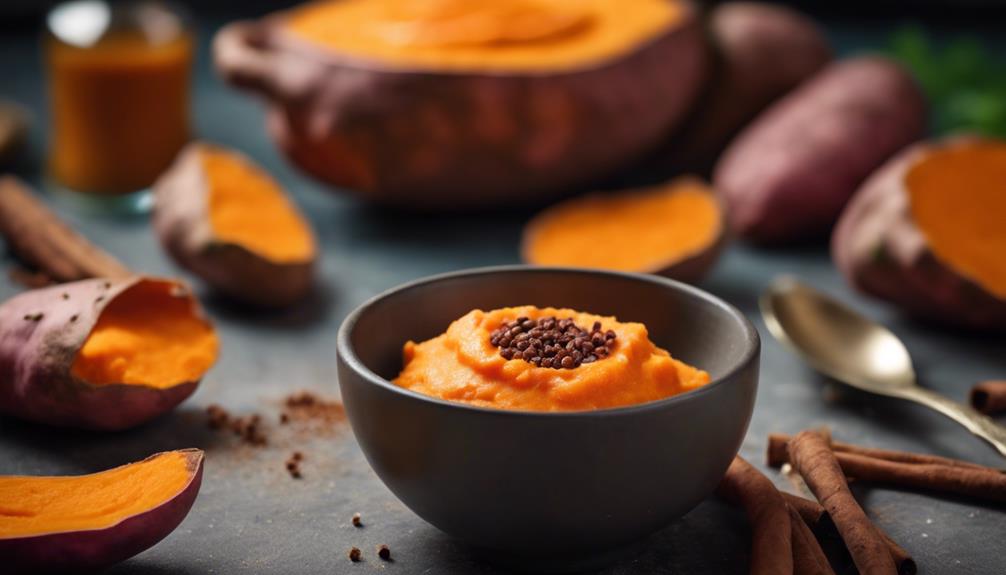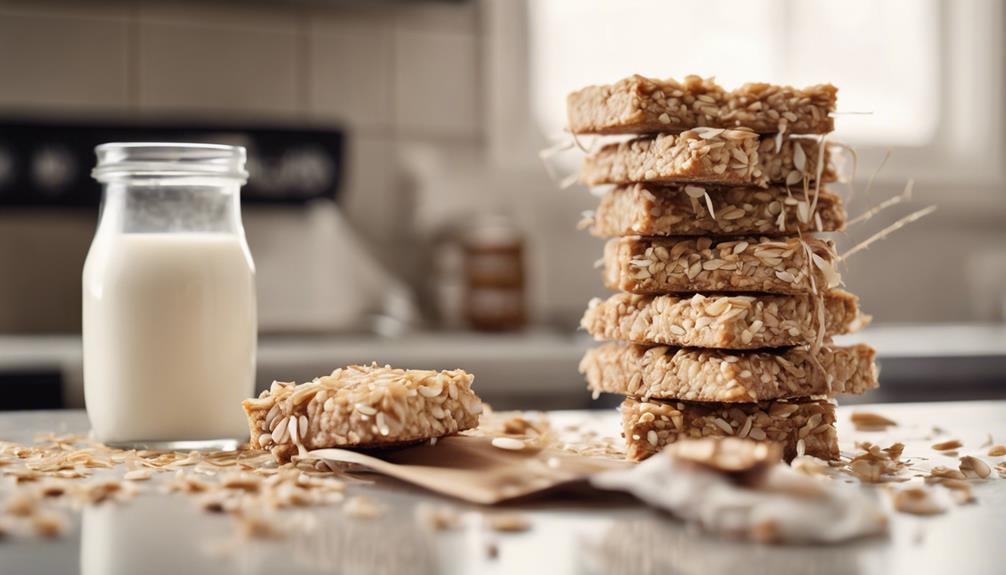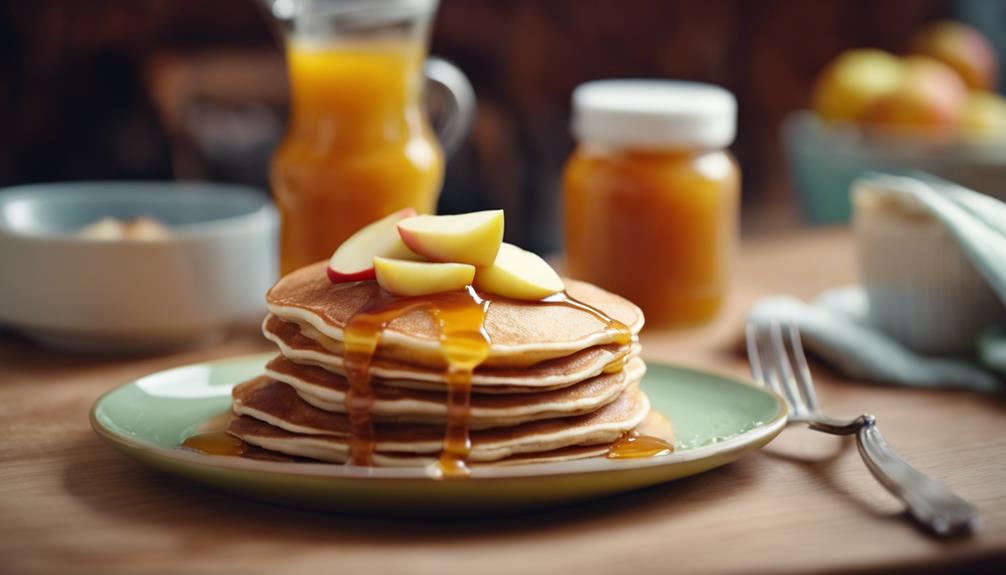To puree pears for your baby, start by simmering them until tender, then blend for a smooth consistency. Add cinnamon for enhanced flavor and extra nutrients. You can use different types of pears like Bartlett, Anjou, or Bosc to customize the puree. Steaming or roasting the pears are top choices, with steaming retaining more nutrients and natural flavors, while roasting adds a caramelized sweetness. Pears are rich in fiber, vitamins C and A, and antioxidants, making them a nutritious addition to your baby's diet. Store the puree properly in airtight containers and freeze in small portions for convenience.
Key Takeaways
- Simmer pears until tender for easy blending.
- Add cinnamon for enhanced flavor and nutrients.
- Choose different pear types for variety.
- Watch a video tutorial for efficient preparation.
- Store in portions for convenient use.
Recipe Details
For clear guidance on creating the pear baby puree, check out the recipe details below. Pears are a fantastic choice for homemade baby food due to their year-round availability and versatility.
When making the pear puree, simmer the pears until they're tender and then blend them to a smooth consistency. Adding warming spices like cinnamon not only enhances the flavor but also provides additional nutrients for your baby.
You can choose from a variety of pear types to customize the puree based on your baby's preferences. Whether it's Bartlett, Anjou, or Bosc pears, each brings a slightly different flavor profile to the dish. By incorporating these different varieties, you can introduce your baby to a range of tastes early on.
For a step-by-step visual guide, refer to the video tutorial available to assist you throughout the cooking process. This resource guarantees that you can prepare the pear baby puree efficiently and effectively for your little one's mealtime.
Cooking Methods
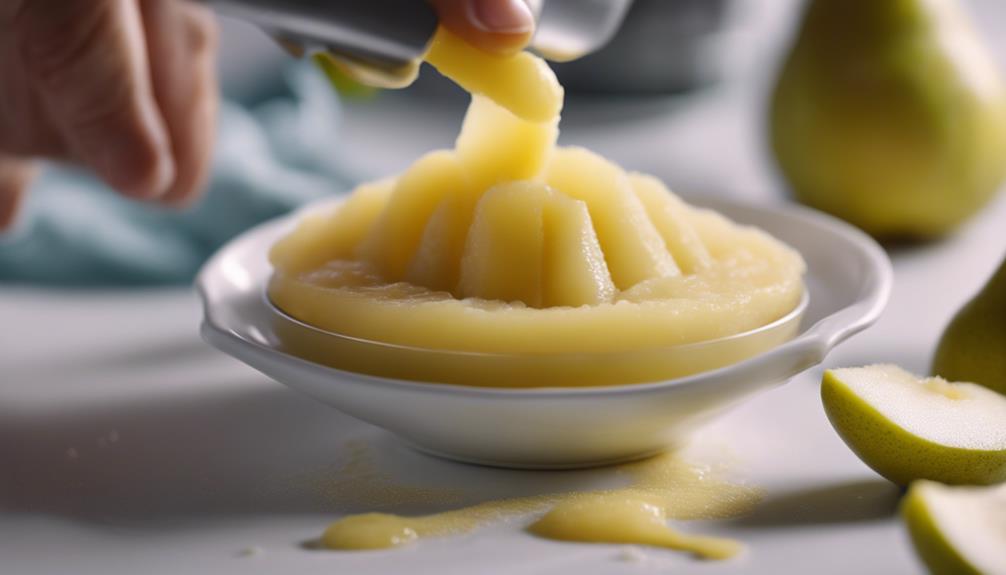
When pureeing pears for baby food, it's important to explore various cooking methods.
Steaming pears retains their nutrients and natural flavors, while roasting adds depth to their taste.
Diversifying cooking techniques enhances the overall flavor profile and introduces babies to a range of tastes.
Cooking Techniques
Wondering which cooking methods work best for pureeing pears for baby food?
When it comes to cooking techniques, steaming and roasting are top choices for preparing pears. Here are some key points to keep in mind:
- Steaming: Steaming pears is a fantastic method as it helps retain the fruit's nutrients and natural flavors, making it an ideal choice for baby food. This gentle cooking process ensures that the pears are cooked through while maintaining their nutritional value.
- Roasting: On the other hand, roasting pears can add depth and caramelization to their flavor profile. This method offers a different taste experience, bringing out the natural sweetness of the fruit and enhancing its overall taste.
- Diversifying Cooking Methods:
Experimenting with various techniques like steaming, roasting, and simmering can provide a range of textures and flavors in your pear puree. By exploring different cooking methods, you can customize the taste and consistency of the puree to suit your preferences.
Flavor Enhancements
To enhance the flavor of your pear puree, consider incorporating warming spices like cinnamon for added depth. Cinnamon can bring a warm and comforting element to the puree, enhancing the natural sweetness of the pears.
Additionally, exploring different cooking methods such as steaming or roasting can further elevate the flavor profile of your baby food.
Steaming pears is a gentle cooking technique that helps retain the nutrients and natural flavors of the fruit. This method guarantees that the pear puree maintains its freshness and delicate taste, perfect for your little one's palate.
On the other hand, roasting pears can add a caramelized sweetness and depth of flavor to the puree. The process of roasting enhances the natural sugars in the pears, creating a rich and indulgent taste that complements the cinnamon beautifully.
Nutritional Information
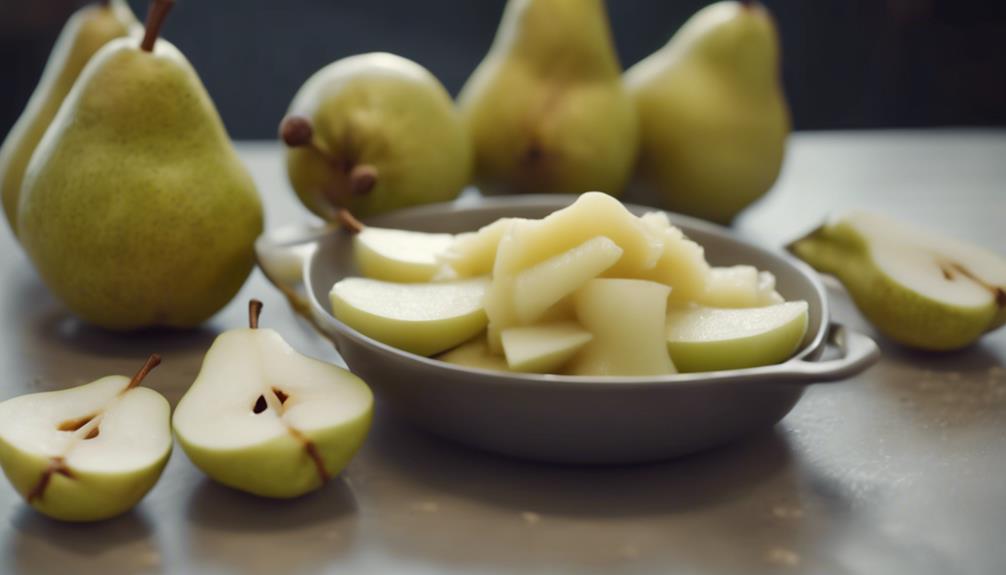
When considering the nutritional information of pureed pears for your baby, you'll find a valuable overview of essential nutrients like fiber, vitamins C and A, and antioxidants.
These nutrients contribute to health benefits such as digestive support, blood sugar regulation, and weight management.
Additionally, serving suggestions cater to babies of all stages, making it a versatile and nutritious addition to your little one's diet.
Nutrient Content Overview
Pears, rich in fiber, vitamins C and A, offer a nutrient-packed option for both babies and adults. When pondering the nutrient content of pureed pears, here are some key points to keep in mind:
- Fiber-Rich: Pears are packed with fiber, aiding in digestion and promoting gut health.
- Vitamin Powerhouse: Loaded with vitamins C and A, pears support a robust immune system and overall health.
- Antioxidant Benefits: Pears contain antioxidants that help protect cells from damage and contribute to your well-being.
Including pear puree in your baby's diet not only introduces them to a gentle and delicious flavor but also provides a natural source of essential nutrients. The low-calorie content and absence of added sugars make pear puree a wholesome choice for both babies and adults.
Health Benefits Highlighted
Considering the nutritional benefits of pureed pears, it's evident that this baby food option offers a wide array of health advantages for both babies and adults. Pears are packed with fiber, antioxidants, and essential vitamins like A and C, making them a nutritious choice for babies' overall well-being.
The fiber content in pears not only aids in digestion but also promotes regular bowel movements, which is particularly beneficial for baby's digestive health. Additionally, the low calorie and high water content in pears help keep babies hydrated. The flavonoids found in the peel of pears provide extra health benefits when consumed.
Serving Suggestions for All
Explore inventive ways to incorporate pear puree into your meals and beverages to enjoy its nutritional benefits and delicious flavor. Whether you're looking to enhance your diet with a healthy and versatile ingredient or add a natural sweetness to your dishes, pear puree can be a fantastic addition.
Here are some serving suggestions for all:
- Baked Goods: Incorporate pear puree into muffins, cakes, or bread for a moist texture and subtle sweetness.
- Oatmeal: Stir pear puree into your morning oatmeal for a fruity twist and added nutrients.
- Smoothies: Blend pear puree with other fruits, yogurt, or milk for an invigorating and nutritious beverage option.
Recipe Ingredients
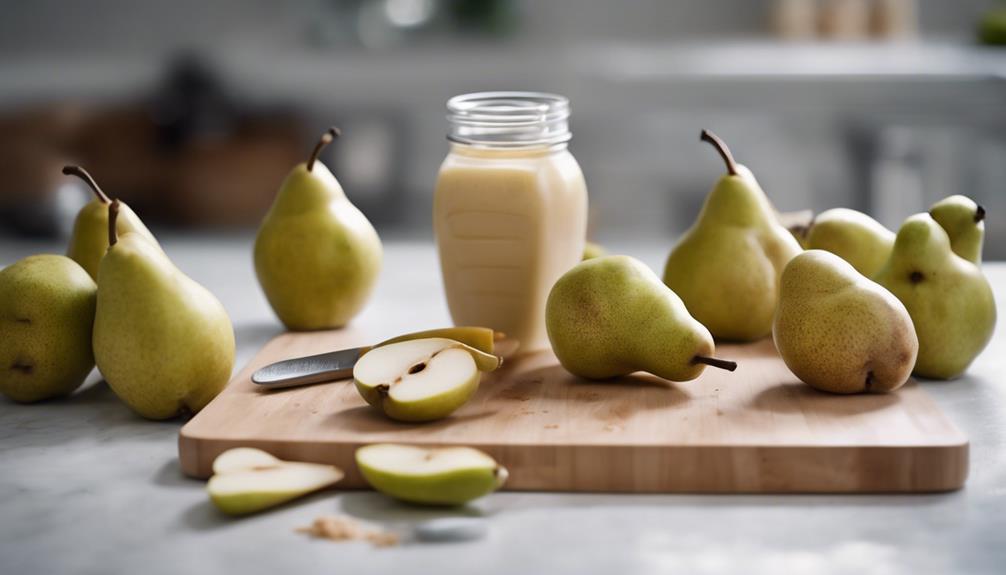
For making pear puree as baby food, you will typically need ripe pears, water, and optional spices like cinnamon. Pears are a fantastic choice for baby food recipes due to their natural sweetness, eliminating the need for added sugars. They are nutrient-rich, providing essential fiber, vitamins, and antioxidants for your baby's development. Different pear varieties can offer unique flavors to the puree, keeping mealtime exciting for your little one. Below is a table showcasing the ingredients required to create a delicious pear puree for your baby:
| Ingredient | Quantity |
|---|---|
| Ripe Pears | 4-5 |
| Water | 1/4 cup |
| Cinnamon | Pinch (optional) |
| Nutmeg | Pinch (optional) |
| Ginger | Pinch (optional) |
Additional Resources
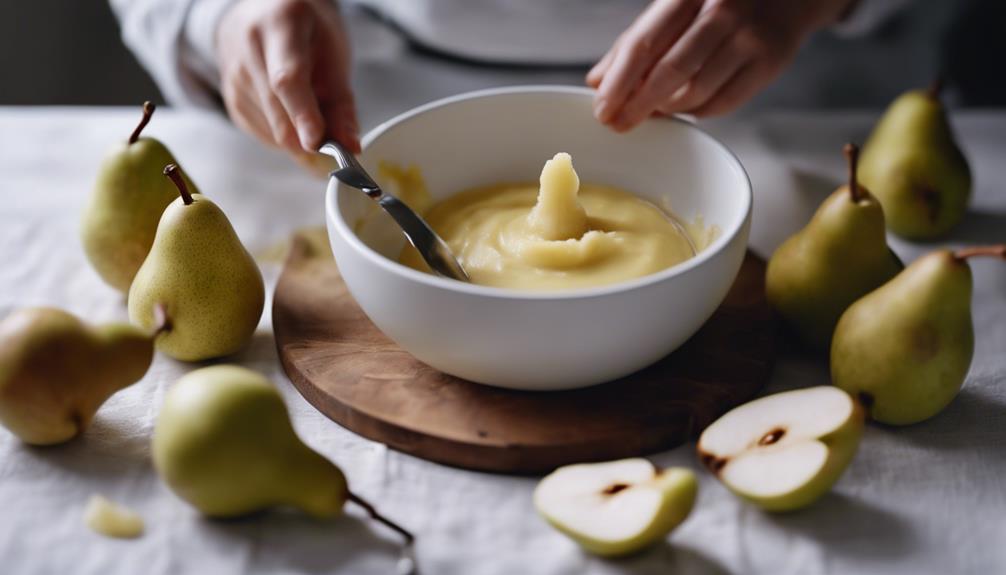
You can find more baby food recipes and valuable meal preparation tips on Simple Gray T-Shirt's platform. Here are some additional resources to help you make the most out of your homemade Pear Baby:
- Explore a variety of flavors and nutrients by trying out recipes like Blueberry Puree, Mango Ice Cream, and Banana Puree.
- Learn from recipe developer Marni Katz, who simplifies meal preparation with easy recipes and menu ideas tailored for busy parents like you.
- Engage with the community on Simple Gray T-Shirt's platform by leaving comments, rating recipes, and connecting with fellow parents who are on a similar baby food-making journey.
For storage tips and other useful information on making homemade baby food, Simple Gray T-Shirt is your go-to resource. Discover the cost efficiency of creating your baby food at home compared to store-bought options, and access the nutrient-rich qualities of pear puree, including its natural sweetness, vitamins, fiber, and antioxidants.
Pear Puree Basics
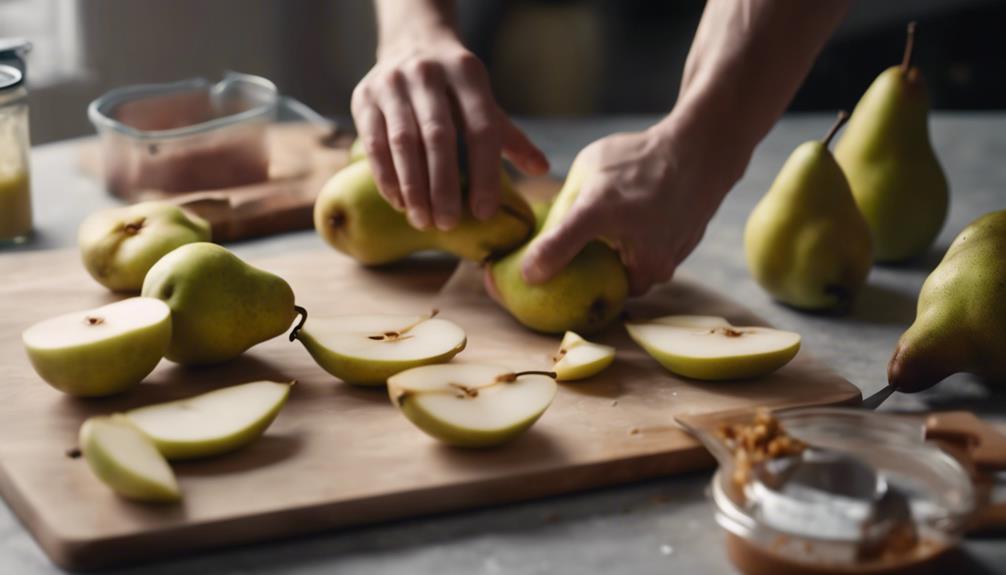
To prepare pear puree, begin by selecting ripe pears and gathering your basic kitchen tools. Homemade baby food like pear puree is a simple recipe that requires minimal ingredients. Here is a basic overview to get you started:
| Kitchen Tools | Ingredients Needed | Preparation Steps |
|---|---|---|
| Blender or Food Processor | Ripe Pears | Wash, peel, and core the pears |
| Knife and Cutting Board | Water | Cut the pears into small chunks |
| Pot or Steamer Basket | Steam the pear chunks until soft | |
| Spoon or Spatula | Blend the steamed pears with water | |
| Airtight Containers | Store the pear puree in containers |
Making pear puree at home guarantees you know exactly what your little one is eating. This simple recipe provides a nutritious and delicious option for babies and toddlers alike. Enjoy the process of creating healthy meals for your child with this easy-to-follow pear puree recipe.
Pear Puree Preparation
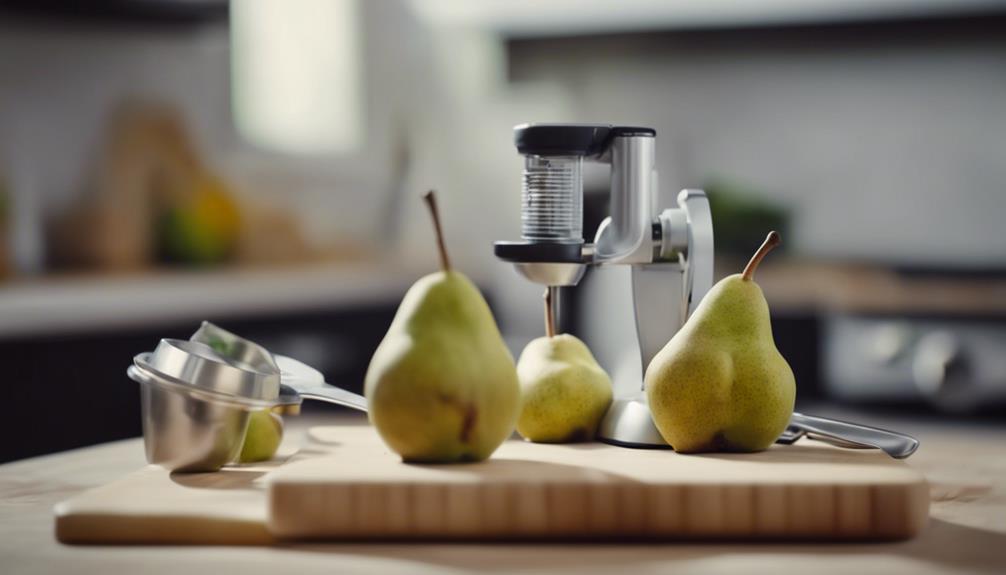
To prepare the pear puree, start by peeling, coring, and chopping fresh pears before cooking them with water and spices until tender. Here are some key steps to keep in mind:
- Simmer: Once the pears are in the pot with water and spices, let them simmer over low heat for 4-15 minutes. This simmering process guarantees the pears become soft and easy to blend.
- Blend: After cooking, blend the pears until smooth using a blender or food processor. This step is essential to achieve a silky and creamy pear puree texture.
- Experiment: Don't be afraid to experiment with different cooking methods like steaming or roasting. These methods can add depth of flavor to your pear puree, making it even more delightful for your little one.
Storing and Using Pear Puree
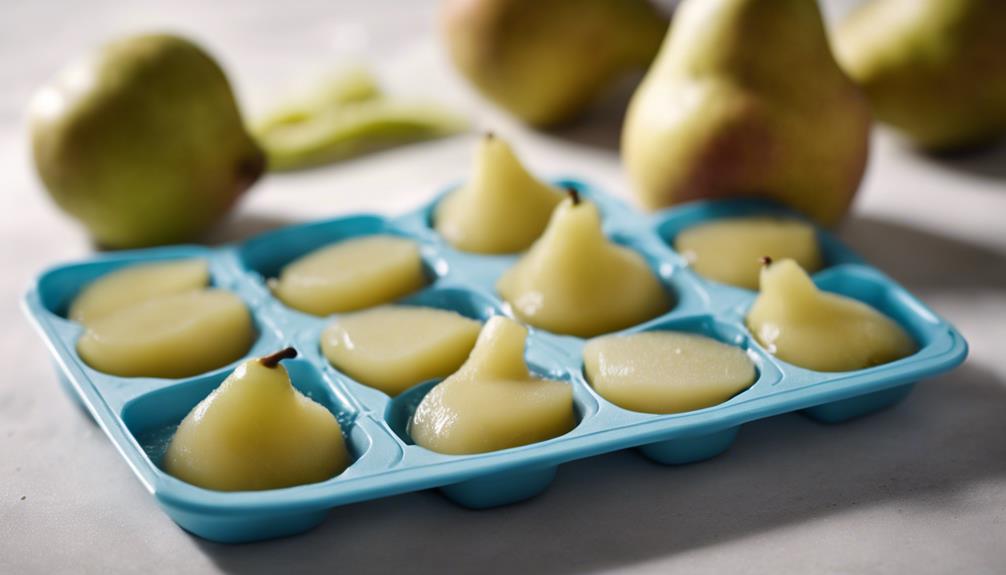
Properly store any leftover pear puree in airtight containers in the fridge for up to 3 days or freeze in small portions for up to 4 months. Remember to label containers with the date for freshness tracking.
When using frozen pear puree, thaw it in the refrigerator before serving. Stir the thawed puree well to guarantee a consistent texture before feeding it to your baby.
Utilize pear puree in a variety of recipes to enhance flavor and nutrition. Blend it into muffins, oatmeal, smoothies, yogurt parfaits, or salad dressings. For a healthier twist, consider substituting oil with pear puree in baking, mixing it into pancake batter, or incorporating it into salad dressings for a unique taste.
Thawed pear puree can be a versatile ingredient, adding a touch of sweetness and nutrients to your dishes. Experiment with different ways of incorporating pear puree into your meals to discover new flavors and textures while providing your baby with a nutritious treat.
Benefits of Pears
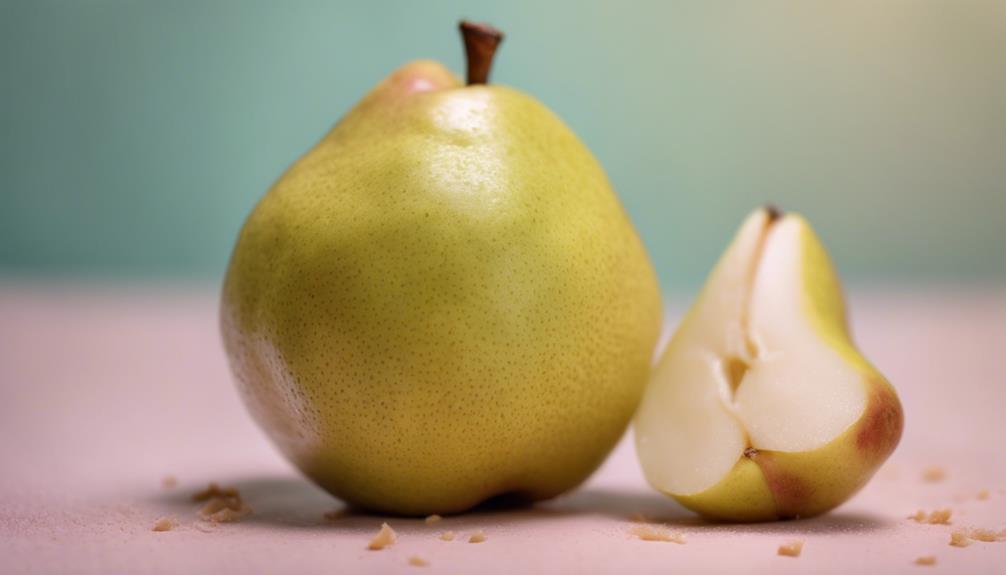
Exploring the nutritional benefits of pears reveals their role in promoting overall well-being and digestive health. Pears aren't just delicious; they pack a punch when it comes to health benefits. Here are three key advantages:
- Rich in Fiber: Pears are a fantastic source of both soluble and insoluble fiber. This fiber content aids in digestion for both babies and adults, promoting gut health and regular bowel movements.
- Antioxidant Powerhouse: Pears are nutrient-dense fruits, loaded with antioxidants, vitamins, and minerals. These compounds help combat oxidative stress in the body, supporting overall well-being.
- Constipation Relief: P fruits like pears are known for their ability to relieve constipation due to their high fiber content. Including pears in your diet can help keep things moving smoothly and support digestive health in the long run.
Frequently Asked Questions
Can I Puree Raw Pear for Baby?
You shouldn't puree raw pear for your baby. It's best to cook the pears first to aid in digestion and soften the fruit. This helps break down fibers, making it easier for your baby to digest.
Do You Peel Pears Before Pureeing?
You can choose to peel pears before pureeing based on your baby's preference and digestion. Experiment with both peeled and unpeeled pears to see what texture and taste your little one enjoys.
How Do You Keep Pureed Pears From Turning Brown?
To keep pureed pears from turning brown, cover them with lemon juice or ascorbic acid, press plastic wrap on top, and refrigerate in an airtight container. Freezing in portions maintains freshness. Use fresh, ripe pears for best results.
What Can I Mix With Pear Puree for Baby Constipation?
To help with baby constipation, mix pear puree with prunes, plums, peaches, or apricots for fiber. Add a bit of water or breast milk to keep hydrated and soften stools. Include whole grain cereals or probiotic-rich foods for better digestion.
Conclusion
To sum up, pureeing pears is a simple and nutritious way to introduce your baby to delicious homemade food. By following the easy steps outlined in this article, you can create a smooth and flavorful puree that your little one will love.
Packed with essential vitamins and minerals, pears offer a range of health benefits for growing infants. So why not give this recipe a try and provide your child with a wholesome and tasty meal option?

